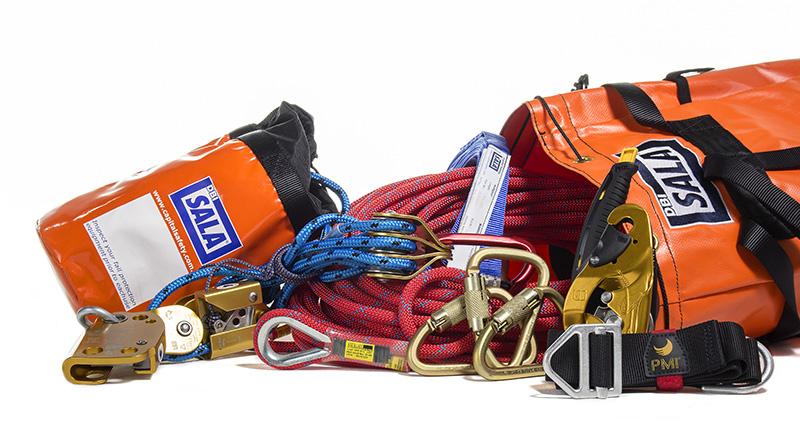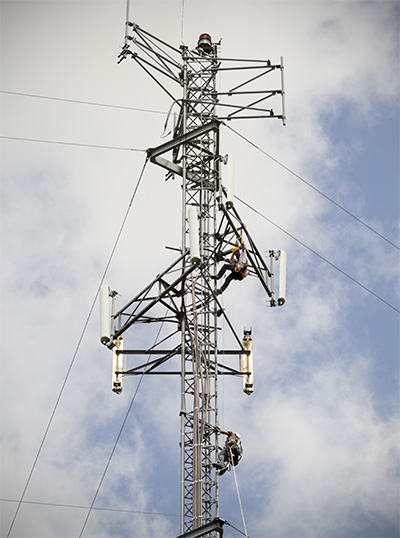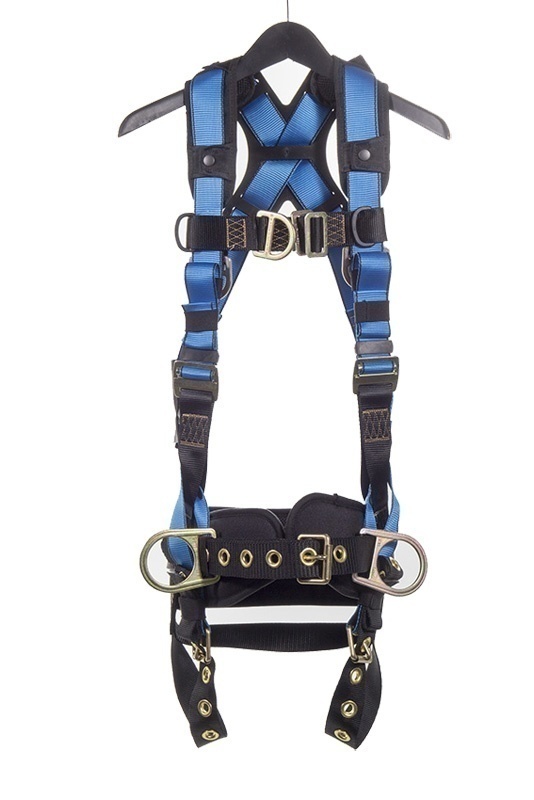Rescue Situations
Ideally, falls don’t happen. But in the event that one does, let’s hope the worker was wearing and using proper fall protection. And let’s also hope that the crew they were working with has been trained to properly rescue a suspended worker.
 If you’re using fall protection, but aren’t properly trained for rescue, and don’t have a rescue plan, you’re only doing half of the job. They’re equally important! And a rescue plan can’t just be calling 9-1-1. Often times Fire and EMS workers are not trained for situations that a suspended worker can be in. Or, the station may not even be close enough to safely get the worker down in time. In a rescue, seconds can make a difference.
Yeah, yeah… we’ve touched on suspension trauma in the past, but it’s a big deal, so we’re doing it again. Suspension trauma can cause potentially serious health issues in as little as 12 to 15 minutes. Blood pools in the legs when hanging in a harness. This can deprive the brain, kidneys, and other organs of oxygen. It’s important to monitor a suspended worker for faintness, nausea, breathlessness, dizziness, unusually low heart rate or blood pressure, paleness, or greying or loss of vision. These are all symptoms that they may be in serious danger. Trauma straps are simple, lightweight, and can prevent a lot of the problems from hanging in suspension.
If you’re using fall protection, but aren’t properly trained for rescue, and don’t have a rescue plan, you’re only doing half of the job. They’re equally important! And a rescue plan can’t just be calling 9-1-1. Often times Fire and EMS workers are not trained for situations that a suspended worker can be in. Or, the station may not even be close enough to safely get the worker down in time. In a rescue, seconds can make a difference.
Yeah, yeah… we’ve touched on suspension trauma in the past, but it’s a big deal, so we’re doing it again. Suspension trauma can cause potentially serious health issues in as little as 12 to 15 minutes. Blood pools in the legs when hanging in a harness. This can deprive the brain, kidneys, and other organs of oxygen. It’s important to monitor a suspended worker for faintness, nausea, breathlessness, dizziness, unusually low heart rate or blood pressure, paleness, or greying or loss of vision. These are all symptoms that they may be in serious danger. Trauma straps are simple, lightweight, and can prevent a lot of the problems from hanging in suspension.
 As for the rescue itself… no two rescues are alike. Take a moment and assess the situation. Can the worker be reached by a bucket, or ladder truck? Is the person conscious or unconscious? How’s the worker suspended? Is there something below the person to lower them to or do they have to come all the way to the ground? Once it’s all decided, the rescue should be performed in the fastest possible way, that doesn’t put the rescue crew in more danger.
Once the worker is safely on the ground, some authorities actually advise against moving the rescued worker to a horizontal position too quickly. There is a potentially large amount of oxygenated blood in the worker's legs, and if that rushes back to the heart too quickly, it could cause cardiac arrest.
Most importantly… the practice saves lives. Every crew should review and go through the physical motions of a rescue frequently. This can help identify what does and doesn’t work, and how it feels to do the actual maneuvers required. Be sure you’re familiar with all of your rescue gear, and how to operate it. If you have any questions, or need to fill out your rescue kit, give us a call and we can make sure you have what you need.
As for the rescue itself… no two rescues are alike. Take a moment and assess the situation. Can the worker be reached by a bucket, or ladder truck? Is the person conscious or unconscious? How’s the worker suspended? Is there something below the person to lower them to or do they have to come all the way to the ground? Once it’s all decided, the rescue should be performed in the fastest possible way, that doesn’t put the rescue crew in more danger.
Once the worker is safely on the ground, some authorities actually advise against moving the rescued worker to a horizontal position too quickly. There is a potentially large amount of oxygenated blood in the worker's legs, and if that rushes back to the heart too quickly, it could cause cardiac arrest.
Most importantly… the practice saves lives. Every crew should review and go through the physical motions of a rescue frequently. This can help identify what does and doesn’t work, and how it feels to do the actual maneuvers required. Be sure you’re familiar with all of your rescue gear, and how to operate it. If you have any questions, or need to fill out your rescue kit, give us a call and we can make sure you have what you need.
 If you’re using fall protection, but aren’t properly trained for rescue, and don’t have a rescue plan, you’re only doing half of the job. They’re equally important! And a rescue plan can’t just be calling 9-1-1. Often times Fire and EMS workers are not trained for situations that a suspended worker can be in. Or, the station may not even be close enough to safely get the worker down in time. In a rescue, seconds can make a difference.
Yeah, yeah… we’ve touched on suspension trauma in the past, but it’s a big deal, so we’re doing it again. Suspension trauma can cause potentially serious health issues in as little as 12 to 15 minutes. Blood pools in the legs when hanging in a harness. This can deprive the brain, kidneys, and other organs of oxygen. It’s important to monitor a suspended worker for faintness, nausea, breathlessness, dizziness, unusually low heart rate or blood pressure, paleness, or greying or loss of vision. These are all symptoms that they may be in serious danger. Trauma straps are simple, lightweight, and can prevent a lot of the problems from hanging in suspension.
If you’re using fall protection, but aren’t properly trained for rescue, and don’t have a rescue plan, you’re only doing half of the job. They’re equally important! And a rescue plan can’t just be calling 9-1-1. Often times Fire and EMS workers are not trained for situations that a suspended worker can be in. Or, the station may not even be close enough to safely get the worker down in time. In a rescue, seconds can make a difference.
Yeah, yeah… we’ve touched on suspension trauma in the past, but it’s a big deal, so we’re doing it again. Suspension trauma can cause potentially serious health issues in as little as 12 to 15 minutes. Blood pools in the legs when hanging in a harness. This can deprive the brain, kidneys, and other organs of oxygen. It’s important to monitor a suspended worker for faintness, nausea, breathlessness, dizziness, unusually low heart rate or blood pressure, paleness, or greying or loss of vision. These are all symptoms that they may be in serious danger. Trauma straps are simple, lightweight, and can prevent a lot of the problems from hanging in suspension.
 As for the rescue itself… no two rescues are alike. Take a moment and assess the situation. Can the worker be reached by a bucket, or ladder truck? Is the person conscious or unconscious? How’s the worker suspended? Is there something below the person to lower them to or do they have to come all the way to the ground? Once it’s all decided, the rescue should be performed in the fastest possible way, that doesn’t put the rescue crew in more danger.
Once the worker is safely on the ground, some authorities actually advise against moving the rescued worker to a horizontal position too quickly. There is a potentially large amount of oxygenated blood in the worker's legs, and if that rushes back to the heart too quickly, it could cause cardiac arrest.
Most importantly… the practice saves lives. Every crew should review and go through the physical motions of a rescue frequently. This can help identify what does and doesn’t work, and how it feels to do the actual maneuvers required. Be sure you’re familiar with all of your rescue gear, and how to operate it. If you have any questions, or need to fill out your rescue kit, give us a call and we can make sure you have what you need.
As for the rescue itself… no two rescues are alike. Take a moment and assess the situation. Can the worker be reached by a bucket, or ladder truck? Is the person conscious or unconscious? How’s the worker suspended? Is there something below the person to lower them to or do they have to come all the way to the ground? Once it’s all decided, the rescue should be performed in the fastest possible way, that doesn’t put the rescue crew in more danger.
Once the worker is safely on the ground, some authorities actually advise against moving the rescued worker to a horizontal position too quickly. There is a potentially large amount of oxygenated blood in the worker's legs, and if that rushes back to the heart too quickly, it could cause cardiac arrest.
Most importantly… the practice saves lives. Every crew should review and go through the physical motions of a rescue frequently. This can help identify what does and doesn’t work, and how it feels to do the actual maneuvers required. Be sure you’re familiar with all of your rescue gear, and how to operate it. If you have any questions, or need to fill out your rescue kit, give us a call and we can make sure you have what you need.












